Xiao Xu
Manager: Aggregating Insights from Unimodal Experts in Two-Tower VLMs and MLLMs
Jun 13, 2025Abstract:Two-Tower Vision--Language Models (VLMs) have demonstrated strong performance across various downstream VL tasks. While BridgeTower further enhances performance by building bridges between encoders, it \textit{(i)} suffers from ineffective layer-by-layer utilization of unimodal representations, \textit{(ii)} restricts the flexible exploitation of different levels of unimodal semantic knowledge, and \textit{(iii)} is limited to the evaluation on traditional low-resolution datasets only with the Two-Tower VLM architecture. In this work, we propose Manager, a lightweight, efficient and effective plugin that adaptively aggregates insights from different levels of pre-trained unimodal experts to facilitate more comprehensive VL alignment and fusion. First, under the Two-Tower VLM architecture, we introduce ManagerTower, a novel VLM that introduces the manager in each cross-modal layer. Whether with or without VL pre-training, ManagerTower outperforms previous strong baselines and achieves superior performance on 4 downstream VL tasks. Moreover, we extend our exploration to the latest Multimodal Large Language Model (MLLM) architecture. We demonstrate that LLaVA-OV-Manager significantly boosts the zero-shot performance of LLaVA-OV across different categories of capabilities, images, and resolutions on 20 downstream datasets, whether the multi-grid algorithm is enabled or not. In-depth analysis reveals that both our manager and the multi-grid algorithm can be viewed as a plugin that improves the visual representation by capturing more diverse visual details from two orthogonal perspectives (depth and width). Their synergy can mitigate the semantic ambiguity caused by the multi-grid algorithm and further improve performance. Code and models are available at https://github.com/LooperXX/ManagerTower.
Visual Thoughts: A Unified Perspective of Understanding Multimodal Chain-of-Thought
May 21, 2025Abstract:Large Vision-Language Models (LVLMs) have achieved significant success in multimodal tasks, with multimodal chain-of-thought (MCoT) further enhancing performance and interpretability. Recent MCoT methods fall into two categories: (i) Textual-MCoT (T-MCoT), which takes multimodal input and produces textual output; and (ii) Interleaved-MCoT (I-MCoT), which generates interleaved image-text outputs. Despite advances in both approaches, the mechanisms driving these improvements are not fully understood. To fill this gap, we first reveal that MCoT boosts LVLMs by incorporating visual thoughts, which convey image information to the reasoning process regardless of the MCoT format, depending only on clarity and conciseness of expression. Furthermore, to explore visual thoughts systematically, we define four distinct forms of visual thought expressions and analyze them comprehensively. Our findings demonstrate that these forms differ in clarity and conciseness, yielding varying levels of MCoT improvement. Additionally, we explore the internal nature of visual thoughts, finding that visual thoughts serve as intermediaries between the input image and reasoning to deeper transformer layers, enabling more advanced visual information transmission. We hope that the visual thoughts can inspire further breakthroughs for future MCoT research.
DeepNuParc: A Novel Deep Clustering Framework for Fine-scale Parcellation of Brain Nuclei Using Diffusion MRI Tractography
Mar 10, 2025Abstract:Brain nuclei are clusters of anatomically distinct neurons that serve as important hubs for processing and relaying information in various neural circuits. Fine-scale parcellation of the brain nuclei is vital for a comprehensive understanding of its anatomico-functional correlations. Diffusion MRI tractography is an advanced imaging technique that can estimate the brain's white matter structural connectivity to potentially reveal the topography of the nuclei of interest for studying its subdivisions. In this work, we present a deep clustering pipeline, namely DeepNuParc, to perform automated, fine-scale parcellation of brain nuclei using diffusion MRI tractography. First, we incorporate a newly proposed deep learning approach to enable accurate segmentation of the nuclei of interest directly on the dMRI data. Next, we design a novel streamline clustering-based structural connectivity feature for a robust representation of voxels within the nuclei. Finally, we improve the popular joint dimensionality reduction and k-means clustering approach to enable nuclei parcellation at a finer scale. We demonstrate DeepNuParc on two important brain structures, i.e. the amygdala and the thalamus, that are known to have multiple anatomically and functionally distinct nuclei subdivisions. Experimental results show that DeepNuParc enables consistent parcellation of the nuclei into multiple parcels across multiple subjects and achieves good correspondence with the widely used coarse-scale atlases. Our codes are available at https://github.com/HarlandZZC/deep_nuclei_parcellation.
Enhanced SPS Velocity-adaptive Scheme: Access Fairness in 5G NR V2I Networks
Jan 16, 2025Abstract:Vehicle-to-Infrastructure (V2I) technology enables information exchange between vehicles and road infrastructure. Specifically, when a vehicle approaches a roadside unit (RSU), it can exchange information with the RSU to obtain accurate data that assists in driving. With the release of the 3rd Generation Partnership Project (3GPP) Release 16, which includes the 5G New Radio (NR) Vehicle-to-Everything (V2X) standards, vehicles typically adopt mode-2 communication using sensing-based semi-persistent scheduling (SPS) for resource allocation. In this approach, vehicles identify candidate resources within a selection window and exclude ineligible resources based on information from a sensing window. However, vehicles often drive at different speeds, resulting in varying amounts of data transmission with RSUs as they pass by, which leads to unfair access. Therefore, it is essential to design an access scheme that accounts for different vehicle speeds to achieve fair access across the network. This paper formulates an optimization problem for vehicular networks and proposes a multi-objective optimization scheme to address it by adjusting the selection window in the SPS mechanism of 5G NR V2I mode-2. Simulation results demonstrate the effectiveness of the proposed scheme
Can Large Language Models Understand You Better? An MBTI Personality Detection Dataset Aligned with Population Traits
Dec 17, 2024Abstract:The Myers-Briggs Type Indicator (MBTI) is one of the most influential personality theories reflecting individual differences in thinking, feeling, and behaving. MBTI personality detection has garnered considerable research interest and has evolved significantly over the years. However, this task tends to be overly optimistic, as it currently does not align well with the natural distribution of population personality traits. Specifically, (1) the self-reported labels in existing datasets result in incorrect labeling issues, and (2) the hard labels fail to capture the full range of population personality distributions. In this paper, we optimize the task by constructing MBTIBench, the first manually annotated high-quality MBTI personality detection dataset with soft labels, under the guidance of psychologists. As for the first challenge, MBTIBench effectively solves the incorrect labeling issues, which account for 29.58% of the data. As for the second challenge, we estimate soft labels by deriving the polarity tendency of samples. The obtained soft labels confirm that there are more people with non-extreme personality traits. Experimental results not only highlight the polarized predictions and biases in LLMs as key directions for future research, but also confirm that soft labels can provide more benefits to other psychological tasks than hard labels. The code and data are available at https://github.com/Personality-NLP/MbtiBench.
Exploring Multi-Grained Concept Annotations for Multimodal Large Language Models
Dec 08, 2024



Abstract:Multimodal Large Language Models (MLLMs) excel in vision--language tasks by pre-training solely on coarse-grained concept annotations (e.g., image captions). We hypothesize that integrating fine-grained concept annotations (e.g., object labels and object regions) will further improve performance, as both data granularities complement each other in terms of breadth and depth in concept representation. We introduce a new dataset featuring Multimodal Multi-Grained Concept annotations (MMGiC) for MLLMs. In constructing MMGiC, we explore the impact of different data recipes on multimodal comprehension and generation. Our analyses reveal that multi-grained concept annotations integrate and complement each other, under our structured template and a general MLLM framework. We clearly explore and demonstrate the potential of MMGiC to help MLLMs better locate and learn concepts, aligning vision and language at multiple granularities. We further validate our hypothesis by investigating the fair comparison and effective collaboration between MMGiC and image--caption data on 12 multimodal comprehension and generation benchmarks, e.g., their appropriate combination achieve 3.95% and 2.34% absolute improvements over image--caption data alone on POPE and SEED-Bench. Code, data and models will be available at https://github.com/LooperXX/MMGiC.
V-DPO: Mitigating Hallucination in Large Vision Language Models via Vision-Guided Direct Preference Optimization
Nov 05, 2024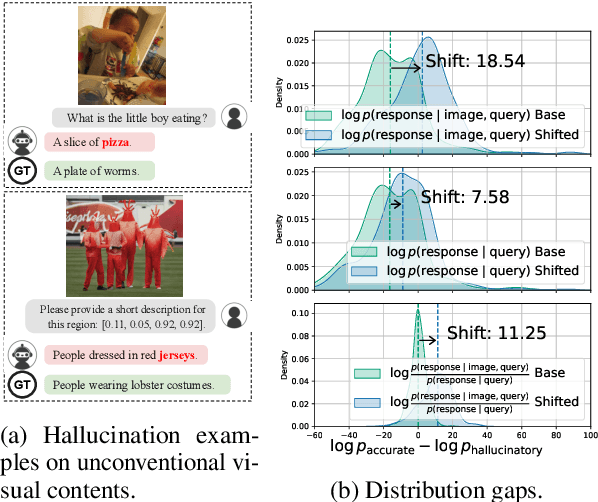
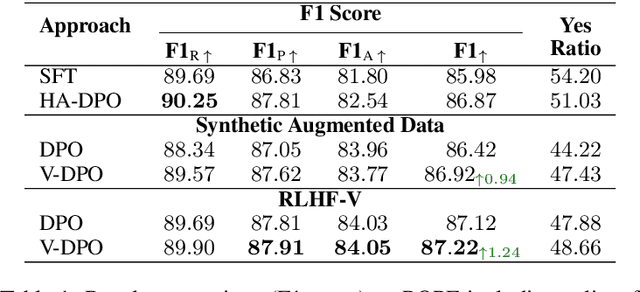
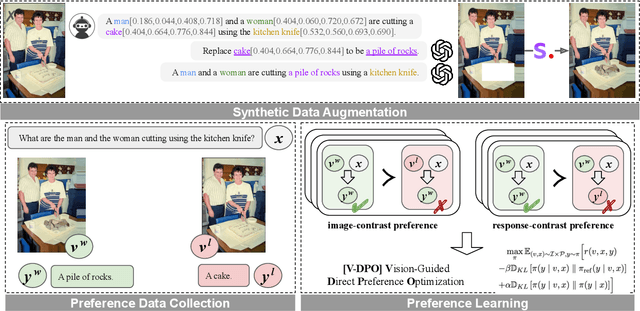
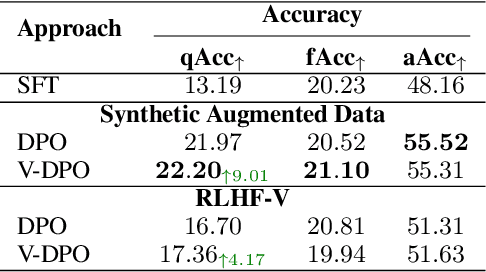
Abstract:Large vision-language models (LVLMs) suffer from hallucination, resulting in misalignment between the output textual response and the input visual content. Recent research indicates that the over-reliance on the Large Language Model (LLM) backbone, as one cause of the LVLM hallucination, inherently introduces bias from language priors, leading to insufficient context attention to the visual inputs. We tackle this issue of hallucination by mitigating such over-reliance through preference learning. We propose Vision-guided Direct Preference Optimization (V-DPO) to enhance visual context learning at training time. To interpret the effectiveness and generalizability of V-DPO on different types of training data, we construct a synthetic dataset containing both response- and image-contrast preference pairs, compared against existing human-annotated hallucination samples. Our approach achieves significant improvements compared with baseline methods across various hallucination benchmarks. Our analysis indicates that V-DPO excels in learning from image-contrast preference data, demonstrating its superior ability to elicit and understand nuances of visual context. Our code is publicly available at https://github.com/YuxiXie/V-DPO.
COrAL: Order-Agnostic Language Modeling for Efficient Iterative Refinement
Oct 12, 2024



Abstract:Iterative refinement has emerged as an effective paradigm for enhancing the capabilities of large language models (LLMs) on complex tasks. However, existing approaches typically implement iterative refinement at the application or prompting level, relying on autoregressive (AR) modeling. The sequential token generation in AR models can lead to high inference latency. To overcome these challenges, we propose Context-Wise Order-Agnostic Language Modeling (COrAL), which incorporates iterative refinement directly into the LLM architecture while maintaining computational efficiency. Our approach models multiple token dependencies within manageable context windows, enabling the model to perform iterative refinement internally during the generation process. Leveraging the order-agnostic nature of COrAL, we introduce sliding blockwise order-agnostic decoding, which performs multi-token forward prediction and backward reconstruction within context windows. This allows the model to iteratively refine its outputs in parallel in the sliding block, effectively capturing diverse dependencies without the high inference cost of sequential generation. Empirical evaluations on reasoning tasks demonstrate that COrAL improves performance and inference speed, respectively, achieving absolute accuracy gains of $4.6\%$ on GSM8K and $4.0\%$ on LogiQA, along with inference speedups of up to $3.9\times$ over next-token baselines. Preliminary results on code generation indicate a drop in pass rates due to inconsistencies in order-agnostic outputs, highlighting the inherent quality--speed trade-off. Our code is publicly available at https://github.com/YuxiXie/COrAL.
In-Context Transfer Learning: Demonstration Synthesis by Transferring Similar Tasks
Oct 02, 2024



Abstract:In-context learning (ICL) is an effective approach to help large language models (LLMs) adapt to various tasks by providing demonstrations of the target task. Considering the high cost of labeling demonstrations, many methods propose synthesizing demonstrations from scratch using LLMs. However, the quality of the demonstrations synthesized from scratch is limited by the capabilities and knowledge of LLMs. To address this, inspired by transfer learning, we propose In-Context Transfer Learning (ICTL), which synthesizes target task demonstrations by transferring labeled demonstrations from similar source tasks. ICTL consists of two steps: source sampling and target transfer. First, we define an optimization objective, which minimizes transfer error to sample source demonstrations similar to the target task. Then, we employ LLMs to transfer the sampled source demonstrations to the target task, matching the definition and format of the target task. Experiments on Super-NI show that ICTL outperforms synthesis from scratch by 2.0% on average, demonstrating the effectiveness of our method.
DQFormer: Towards Unified LiDAR Panoptic Segmentation with Decoupled Queries
Aug 28, 2024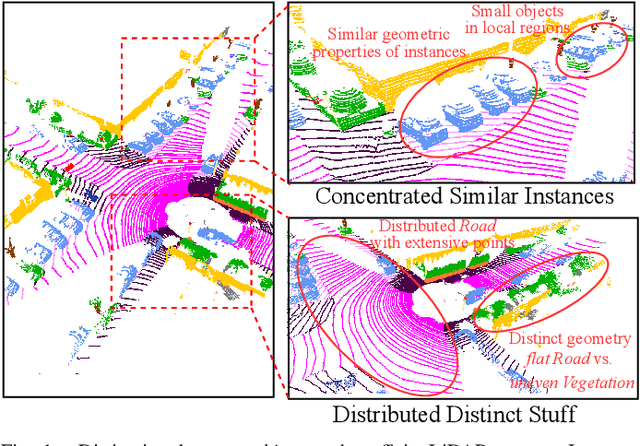
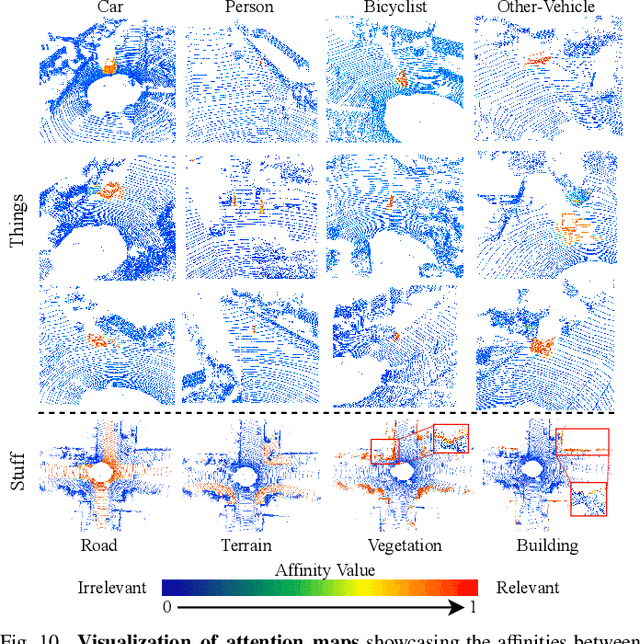
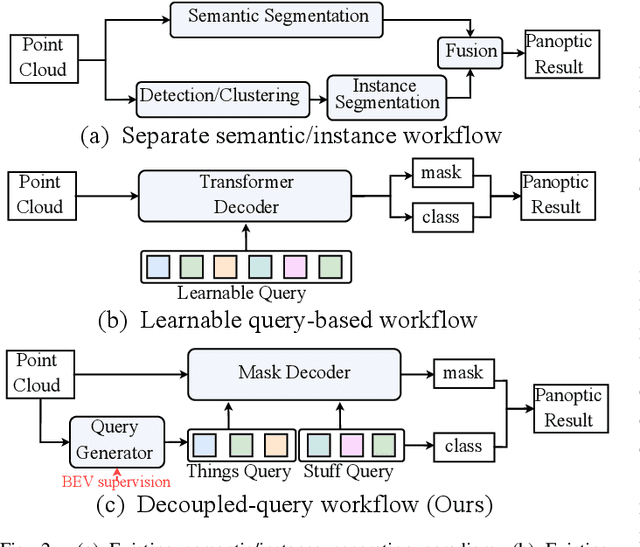
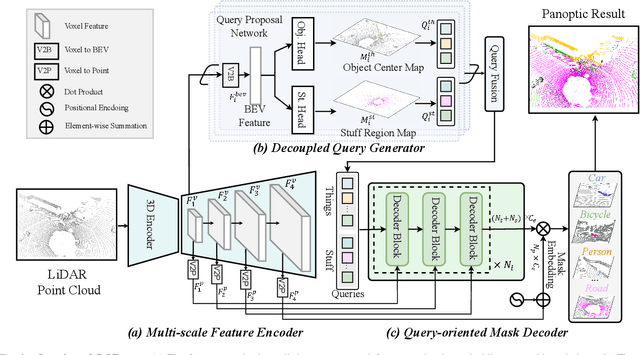
Abstract:LiDAR panoptic segmentation, which jointly performs instance and semantic segmentation for things and stuff classes, plays a fundamental role in LiDAR perception tasks. While most existing methods explicitly separate these two segmentation tasks and utilize different branches (i.e., semantic and instance branches), some recent methods have embraced the query-based paradigm to unify LiDAR panoptic segmentation. However, the distinct spatial distribution and inherent characteristics of objects(things) and their surroundings(stuff) in 3D scenes lead to challenges, including the mutual competition of things/stuff and the ambiguity of classification/segmentation. In this paper, we propose decoupling things/stuff queries according to their intrinsic properties for individual decoding and disentangling classification/segmentation to mitigate ambiguity. To this end, we propose a novel framework dubbed DQFormer to implement semantic and instance segmentation in a unified workflow. Specifically, we design a decoupled query generator to propose informative queries with semantics by localizing things/stuff positions and fusing multi-level BEV embeddings. Moreover, a query-oriented mask decoder is introduced to decode corresponding segmentation masks by performing masked cross-attention between queries and mask embeddings. Finally, the decoded masks are combined with the semantics of the queries to produce panoptic results. Extensive experiments on nuScenes and SemanticKITTI datasets demonstrate the superiority of our DQFormer framework.
 Add to Chrome
Add to Chrome Add to Firefox
Add to Firefox Add to Edge
Add to Edge